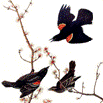Center, Internet, Wildlife Damage Management

Bird Control Seminars Proceedings
A LOW-LEVEL TREATMENT OF THE AVIAN REPELLENT, METHIOCARB, ON RIPENING SWEET CHERRIES
Document Type
Article
Date of this Version
October 1973
Abstract
Ripening cherries are often highly susceptible to damage by many species of birds. According to a survey conducted by Stone (in press) in 1972, birds damaged about 16 percent of the tart cherry crop in Michigan. Sweet cherries are generally considered to be even more vulnerable to birds than tart cherries. Since most birds that damage cherries are of desirable species, nonlethal means must be used to protect the crop. However, most of the mechanical or physical techniques used in the past are costly, time-consuming, or effective only for short periods. Recently an experimental insecticide, methiocarb [4-(methylthio)-3, 5-xylyl N-methylcarbamate], proved to be an effective bird repellent for many crops (Guarino, 1972). In 1971, tests were conducted in Michigan to determine whether an insecticidal level of methiocarb (1 1b. per 100 gal water) would reduce bird damage to ripening sweet cherries of the Mazzard variety (Prunus avium) and ripening European wild tart cherries (P. mahaleb); bird damage was reduced more than 60 percent in treated trees in both orchards (Guarino et al., in press). In 1972, we conducted a follow-up test to determine the effectiveness of a lower concentration of methiocarb on ripening sweet cherries.

